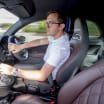Cupra Born review: performance, motor & drive
The Cupra Born is hands-down one of the best family electric cars to drive
|
Battery and motor |
0-62mph |
Top speed |
Driven wheels |
|
58kWh/201bhp |
7.3s |
99mph |
Rear |
|
58/kWh228bhp |
6.6s |
99mph |
Rear |
|
77/kWh228bhp |
7.0s |
99mph |
Rear |
For a long time, Cupra was simply a performance arm of the SEAT brand. Nowadays, even though Cupra is a standalone brand, these sporting credentials remain apparent – especially in the brand’s first electric model. Sharing parts with the Volkswagen ID.3, the Cupra Born feels a lot more dialled-in than its German counterpart, offering sharper handling and the option of a more powerful electric motor.
Cupra Born 0-62mph, top speed and acceleration
Entry-level Cupra Born models come fitted with a 58kWh battery, as well as a 201bhp electric motor – the same one found in the VW ID.3. While a 0-62mph time of 7.3 seconds doesn’t sound all too quick by EV standards, the instant torque offered by both of the Cupra Born’s powertrains mean all versions feel faster than the numbers suggest.
The fastest-accelerating model in the Born range uses a 228bhp motor. Badged ‘e-Boost’ this punchier powertrain is only available on the flashier V2 and V3 specs, but manages to slash the Cupra’s 0-62mph time to just 6.6 seconds – or 31mph from a standstill in 2.6 seconds.
Go for the bigger battery – also found on the long-range variants of Volkswagen's ID.3 and VW ID.4 – and you’ll get e-Boost as standard, though the heavier battery means the top-spec Cupra isn’t quite as quick; this model will do 0-62mph in seven seconds.
The Born is rear-drive only for the time being, however, a hot version of the Cupra has been spied testing, and will likely use the same dual-motor powertrain as the Volkswagen ID.3 GTX due to arrive later in 2023.
Handling
If you’ve spent any time in the Volkswagen ID.3, you’ll quickly notice how the Cupra Born feels much stiffer than its mechanical sibling. A low centre of gravity pairs well the Born’s rear-wheel-drive setup to provide a driving experience akin more to a sports car than a practical family hatchback. Switch the car into its raciest ‘Cupra’ mode and this makes things even more exciting thanks to enhanced throttle response and more weight being added to the steering; there isn’t much in the way of feel or feedback, though.
One might expect that all of this comes at the expense of comfort, however we’re happy to report that this isn’t the case; while we think the smaller 18-inch wheels on the V1 model offer the best compromise when it comes to ride and handling, the larger alloys of top-spec cars don’t have too much of a negative impact and are more than palatable on longer driving stints.
One final thing to mention is the Cupra Born’s brakes. The conventional brakes offer good, progressive feel, but even in its most aggressive setting, the regenerative system isn’t strong enough to allow for one-pedal driving. It’s sufficient for slowing the car in faster-flowing traffic or for wide, open bends, but is some way off the strength of the Megane E-TECH's system.




